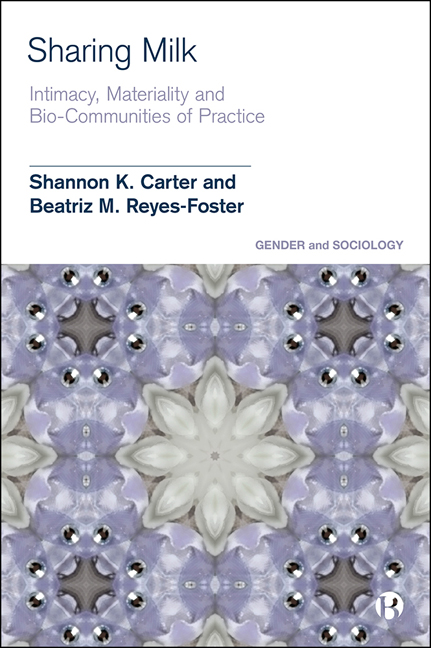Book contents
- Frontmatter
- Dedication
- Contents
- List of Figures and Tables
- Notes on the Authors
- Acknowledgements
- Preface
- 1 Introduction: Sharing Milk
- 2 Theorizing Milk Sharing
- 3 Entering Bio-Communities of Practice
- 4 Milk-Sharing Practices
- 5 The Milk-Sharing Network
- 6 Conclusion
- Notes
- Appendix A Survey Participant Demographics
- Appendix B Interview Participant Demographics
- References
- Index
4 - Milk-Sharing Practices
Published online by Cambridge University Press: 10 March 2021
- Frontmatter
- Dedication
- Contents
- List of Figures and Tables
- Notes on the Authors
- Acknowledgements
- Preface
- 1 Introduction: Sharing Milk
- 2 Theorizing Milk Sharing
- 3 Entering Bio-Communities of Practice
- 4 Milk-Sharing Practices
- 5 The Milk-Sharing Network
- 6 Conclusion
- Notes
- Appendix A Survey Participant Demographics
- Appendix B Interview Participant Demographics
- References
- Index
Summary
5.30 am. A baby stirs, then cries. His mother, Cassie, lying in bed beside him, latches him to her breast, half asleep, and the nursling settles. A few minutes later, she gets up and heads to her rocking chair in the room next door, where her double electric pump is set up. She sits down and starts her morning pumping routine, washing her hands beforehand and ensuring all of her pump parts are clean and sanitized. Twenty minutes later, after making sure she washes her hands again, she carefully transfers the milk to storage bags, lays them flat on a cookie sheet, and places them in the freezer. Once they freeze flat, she will stack them neatly and slide them into a gallon-sized storage bag that will go into a specially designated freezer in her garage. Throughout her day, she repeats this same routine at least four times. By the end of the week, her freezer will be full of gallon-sized zipper bags full of eight-ounce milk-storage bags. Some of the milk is meant for Get Pumped, but on any given week she might offer some up to a desperate mother posting on Human Milk 4 Human Babies, or to a friend of a friend who is just not making enough milk. Cassie is very proud of the fact that she produces thick, creamy milk – she calls it buttermilk – and she's sure the babies she has fed have benefitted greatly from it. Meeting babies who drink her milk, she says, “lights her heart on fire”.
Meanwhile, in another part of town, another mother, Thelma, is also starting her day. Her own baby stirs, and she gets up to retrieve the bag of milk she left to defrost in her fridge the day before. She washes her hands, sighs in relief to see the bag didn't leak into the bowl it was sitting in, pours its contents into a bottle, and sets it into a bowl of warm water to heat it. She opens her freezer, frowns at the dwindling supply of frozen milk bags, and grabs her cell phone as she picks up the warmed bottle of donor milk and walks back to her bedroom to feed her baby. She logs on to a local Facebook group and posts some information about herself, her baby, and her need for milk.
- Type
- Chapter
- Information
- Sharing MilkIntimacy, Materiality and Bio-Communities of Practice, pp. 97 - 134Publisher: Bristol University PressPrint publication year: 2020



